| |
MEMORIES
OF THE FRIENDSHIP TRAIN IN FRANCE
(1947-1948)
By Gabrielle Griswold © 2011
We
are all creatures of the historical period into which we were born,
and the trajectory of our individual lives, our perceptions and
our self-awareness, are often historically determined to a far greater
degree than we realize.
I
was born in late-May 1926, eight years after the end of the First
World War, three years before the onset of the Great Depression,
and twelve years before the Second World War began in Europe. In
my youth, the major historical influences were the legacy of World
War I, the Great Depression, and, most formatively, World War II.
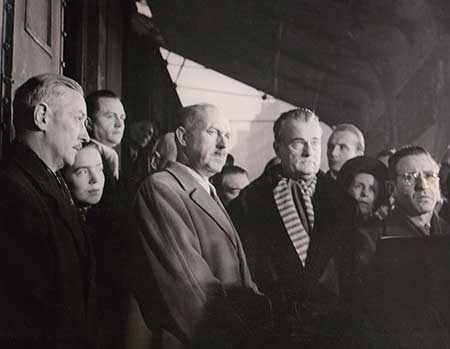 |
This photo relates to the arrival by rail of the Friendship Train in Paris on 20 December 1947, and shows a handful of the dignitaries awaiting its arrival at the Gare St. Lazare. Journalist Drew Pearson is fourth from the left, standing beside American ambassador to France Jefferson Caffrey (wearing striped scarf). My boss, Robert H. Blake, director of American Aid to France, Inc., is first from the left, beside whom I am standing (second from left). Who the others are I do not know. |
For
my relatively affluent family, the Depression was not the complete
disaster it was for so many others. World War I was in the past,
but I did learn something about it from my parents, particularly
from my mother who had been one of a relatively small number of
American women to serve overseas during that war. Under the auspices
of an American-based organization called The Lighthouse she had
gone over first at the age of 25 during the summer of 1916, even
before the U.S. entered the war, to provide music therapy for French
soldiers blinded in battle. She went over again in 1917 with a women's division of the YMCA, then officially considered part of
the American Expeditionary Forces. In that capacity, she and her
colleagues wore uniforms and insignia, slept on cots in tents, and
were stationed behind the lines, where they dispensed hot coffee,
soup, snacks, cigarettes and writing paper to men being rotated
back from the front. After the war, my mother returned from France
and married my father, who had served the war effort as executive
officer of the Dayton, Ohio, office of the Bureau of Aircraft Production.
While
World War I was my parents' war, World War II was mine and my generation's.
Impacting all of my teenage years, it began in Europe when I was
thirteen and ended in the Pacific when I was nineteen.
For
most Americans, World War II did not become of national concern
until the Japanese attack on Pearl Harbor on 7 December 1941. For
me, because of my background, it had started some two years earlier.
At that time, I was in my first school year at the French Lycée
in New York, which I had entered in September 1938 after spending
the year of 1937 in France with my beloved French godmother. My
first Lycée year was the last year of peace for the world at large,
but full-scale war was not far off. Hitler had already annexed Austria
and Czechoslovakia, Kristallnacht had occurred, and the Nazi threat
to democracy worldwide was becoming apparent as Germany accelerated
its massive military build-up.
When
I first entered the Lycée during that fall of 1938, our student
body was composed of French, English and American youngsters. By
the following school year, after the invasion of Poland on 1 September
1939, we began to see the arrival of students from other European
countries, whose families had fled the Nazi menace. We had refugees
from Poland, Italy, Greece, Belgium, The Netherlands and other European
countries, as well as from France and England. Some of our professors
and several of our older male students who answered the call to
fight would die in combat. Many students like myself regularly devoted
some of our free time to volunteering or fundraising for wartime
relief organizations such as Bundles for Britain, British War Relief,
and the Allied Relief Fund. Thus, even before the U.S. entered World
War II, we at the Lycée were highly conscious of it, well before
our contemporaries in American high schools had given it a thought.
I
attended the French Lycée for three-and-a-half years. On 27 and
28 November 1941, my family moved out of Manhattan to Long Island.
Nine days later, on Sunday December 7th, the Japanese attacked Pearl
Harbor. On December 8th, President Roosevelt asked Congress for
a declaration of war against Japan, and Britain also declared war
on Japan. On December 11th, Germany and Italy declared war on the
U.S. Only then did this nation officially join the Allies in their
fight in Europe, thereby expanding the conflict to a global war.
From the outset, our country would be fighting on two fronts. After
that, the war came closer to every American family, of which those
with loved ones in the armed forces were most directly, and often
tragically, affected.
And
now, if I have now chosen to record the following, it is because
I realize that I may well be the only person still alive who can
tell this particular story.
*
* * * * * * * * *
Less
than a month after I turned twenty-one, having finished with high
school and college, I boarded the S/S America in mid-June
1947 and sailed for France. By then two years had passed since the
end of World War II, and most of Europe lay in ruins. Many of us
who had survived the conflict safely in the United States felt an
obligation to do something helpful for our less fortunate neighbors
abroad. Like my mother during WWI, I too felt impelled to contribute
my bit to the larger world.
At
the time, many private postwar relief organizations were sending
personnel and whatever material aid they could muster to devastated
nations overseas. As I had done volunteer work in New York for one
such organization named American Aid to France, I went abroad armed
with letters of recommendation to its Paris office, virtually assured
of a job when I got there. Thus I left the U.S. with the intention
of living and working in France for approximately one year.
Based
in New York, American Aid to France, Inc. (originally American Relief
for France) raised money in the U.S. to fund its operations in France,
and collected food, clothing and medical supplies for shipment to
its Paris headquarters, whence they were distributed to AAtF medico-social
centers in seven of France's most devastated cities, namely Calais,
Dunkerque, Le Havre, Corcieux, Coutances, Forbach and Lorient, all
areas that had sustained much wartime carnage and destruction.
AAtF
headquarters, where I fetched up, were located in Paris in what
was then called Pershing Hall, the American Legion building at 49
rue Pierre Charron (which today houses the jewelry firm of Cartier),
just off the Champs-Elysées a short distance down from the Arc de
Triomphe. There, AAtF personnel oversaw the storage in city warehouses
of supplies shipped to us by the New York office, their delivery
to our centers in the field, and all other aspects of our work in
France.
In
turn, our centers distributed these supplies to local populations
in their respective areas, operated dispensaries and infirmaries,
and worked closely with local doctors, dentists and other health
care professionals in the communities they served to deliver needed
medical services and support. In addition, the centers attempted
to provide social and recreational opportunities for French citizens
debilitated and disheartened by the war, who for so long had known
little but hardship. Axxording to whatever goods and services might
help meet each community's most pressing needs, center personnel
provided transportation, set up libraries or reading rooms, held
sewing classes, cooking classes, woodworking shops, sports programs,
youth programs, kindergartens, open houses, film screenings, games,
dances, and more. Like our Paris office, our centers were staffed
by both American and French personnel. Regrettably, I never did
get out into the field to visit any of them.
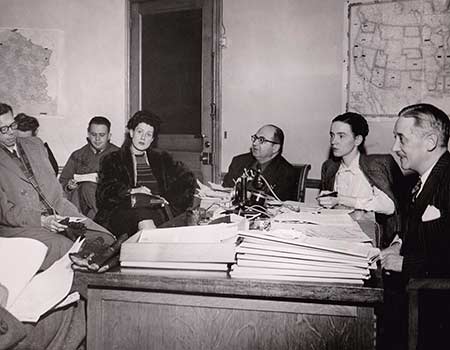 |
This photo shows Blake's American Aid to France office during a Friendship Train Steering Committee meeting, held to discuss Friendship Train distributions throughout France. Blake sits at his desk at far right, I am beside him (second right) taking minutes of the meeting, while representatives of French and American charitable organizations sit opposite us. |
Only
two years after war's end, this was a sad, lean time in Europe,
and it was obvious that many people were in want. In France, food
rationing was still in effect, gasoline and other fuels were in
short supply, apartments were unheated (and they were cold!).
Traffic on even the Champs-Elysées was sparse, featuring a strange
admixture of vehicles, some perfectly normal cars, some three-wheeled
vehicles, some improvised contraptions that seemed little better
than go-carts or motorized wooden boxes, and of course bicycles.
One saw beggars in the street, at the door of our office building
and elsewhere, and we had people coming into our office to plead
for help. I relished my first-ever real adult job because it was
obvious that we were doing useful and needed work.
To
this job, I brought both bilingual and secretarial skills, which
I employed in the triple capacity of receptionist, keeper of the
office's central files, and part-time secretary as needed. Our director
was Robert H. Blake, his assistant-director was Florence Gilliam.
Other than that, the headquarters staff included an administrative
assistant, a couple of secretaries, our director of shipping Louis
Clamaron, our public relations man Herb Conway, a father and son
team named Blandin who supervised work in the warehouses, plus several
others. When I first arrived on the job, Mlle. Colin, the elderly
woman whom I would be replacing, was due to retire but remained
at her post long enough to familiarize me with the organization's
files and teach me what I needed to know about receiving visitors,
official or unofficial, expected or unexpected. I was, by ten years
or more, the youngest member of our Paris office.
This
was the usual routine right up until the fall of 1947, when the unusual happened. At that time, nationally syndicated newspaper-and-radio
journalist Drew Pearson contacted American Aid to France to see
if our organization would head up distributions of the food that
he was collecting in America by means of his Friendship Train.
Sometime
on or about 11 October 1947 in his Baltimore Sun column 'Washington Merry-Go-Round,' Pearson had proposed starting a
freight train of eight empty boxcars on America's West Coast and
sending it across country to New York, stopping at multiple stations
along the way, adding additional cars as it progressed eastward
and filling them at each stop with voluntary donations of food contributed
by individuals, businesses and organizations, for shipment overseas
as a Christmas present to the people of France and Italy. This initiative
was to be a spontaneous grassroots gesture of sympathy and friendship
from the American people, and Americans responded generously. In
the U.S., a national committee had been formed, and, at individual
state and local levels, smaller committees had enthusiastically
organized participation within their own communities. All along
the Train's designated route, and even beyond, everyone wanted to
share in this heartfelt initiative.
As
the Friendship Train started out from Los Angeles on 7 November,
the expectation was that, by the time it reached New York, it might
have made some forty stops and accumulated as many as eighty boxcars
full of provisions. But the final results far exceeded those estimates.
Eleven days later, as it rolled into New York on 18 November, the
Train had grown to include nearly three hundred boxcars, filled
with merchandise worth $40,000,000. (In different accounts, these
figures may vary but many more boxcars had indeed been added, the
number of stops had multiplied, and the main-liner route had been
supplemented by two more railroad lines.) On arrival in New York
on November 19th, the Train received a City Hall welcome and a ticker-tape
parade on Broadway.
For
us in Paris, it was thrilling to think that American citizens had
responded so whole-heartedly to Pearson's Friendship Train appeal.
Not only had free-will donations of food poured in from families,
farms, schools, churches, businesses, corporations, veterans' groups
and other organizations, but other entities had contributed in other
ways. Railroad companies had agreed to move the trains free of charge,
porters' unions had allowed the loading of trucks at no cost, American
telephone companies had set up special switchboards to handle Friendship
Train calls, musicians' unions had provided free music at some stops
while high school bands played at others. Schoolchildren had held
fund-raisers; city mayors and state governors had publicly promoted
the Train; and ordinary citizens turned out for it in droves. When,
on 21 November, it came time to ship the merchandise across the
ocean to France, United States Lines volunteered free transportation
aboard the cargo ship S/S American Leader.
As
a result, by late-fall 1947 AAtF's pace had considerably quickened.
With our organization selected by Pearson as his first choice for
overseeing distributions in France and Blake designated as head
of the Friendship Train Steering Committee that would administer
them, more and more work was now coming into our Paris office. We
were all working frantically against a looming deadline, as Pearson
wanted at least some of the collected merchandise to have been distributed
by Christmas and the New Year. To help handle this load, I became
Blake's full-time Friendship Train secretary.
Initially
Pearson had supposed that the freight train cars loaded with merchandise
collected in America would board ship in New York, debark at Le
Havre, and continue on a ceremonial southbound journey by rail through
France from Paris to Marseille, distributing portions of the merchandise
at each stage of the journey. However, when it turned out that the
gauge of French rails differed from that of American rails, it was
realized that all the collected merchandise would have to be unloaded
in New York, reloaded onto ships and dispatched across the Atlantic
in several stages to France, where it would again be reloaded
onto trains, and thence delivered and distributed. I remember this
issue being discussed at one of our earliest Steering Committee
meetings.
*
* * * * * * * * *
Meanwhile
at this same time, in Washington D.C. Congress was still debating
the implementation of General George C. Marshall's vision of economic
aid to devastated European countries, as proposed in his Harvard
University commencement address of 5 June 1947. That aid, when it
came, would be officially-sponsored government-to-government aid,
subject to certain conditions. Meanwhile, the Friendship Train,
which would precede by six months the Marshall Plan's June 1948
start-up in Europe, was a warm-hearted, entirely voluntary hands-across-the-sea
gift outright from one people to another, with no strings attached.
Despite erroneous assertions sometimes found today on the Internet
and elsewhere to the effect that the Friendship Train had some connection
with the Marshall Plan, in fact it was totally unrelated. It was
no part of that program, not even an introduction to it, nor yet
some sort of trial run for it. It was completely separate, totally
different in nature, and it antedated the Marshall Plan's implementation
by a good half-year. I know this for a certainty because I was
there, and because I was part of both initiatives, each
in its turn.
To recapitulate: General Marshall first proposed the idea of U.S.
government aid to Europe at Harvard in June of 1947, but the Economic
Cooperation Act of 1948 was not passed until ten months later, by
which time the Friendship Train had already happened. It would not
be until sometime in late-June 1948 that the European Recovery Program
(commonly called the 'Marshall Plan') would actually start setting
up in Europe, implemented by the Economic Cooperation Administration.
That was exactly when I left American Aid to France and began working
at E.C.A. headquarters in Paris, at precisely the moment when it
was beginning to launch its European operations.
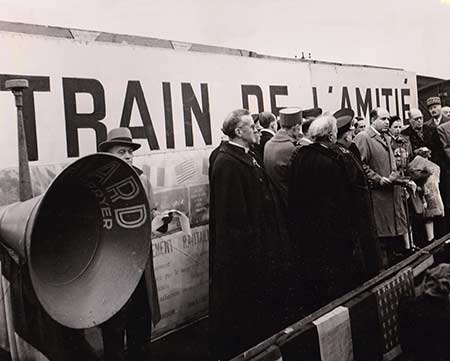 |
This view shows the flat-bed car on which we all gathered whenever the Train pulled into one of the stations on its route from Paris to Marseille. Editor-in-chief of the International Herald Tribune. Geoffrey Parsons, is at the microphone, delivering his speech to the crowd assembled to greet us on the railroad platform below. |
Interestingly,
each program was essentially linked to one man: to Drew Pearson
in the case of the Friendship Train, and to General. Marshall in
the case of the European Recovery Program. A journalist of Quaker
origins, Pearson knew enough about conditions in postwar Europe
to understand that material help and a ray of hope was needed there.
Soldier-statesman Marshall, then Secretary of State, having gone
abroad in early 1947, knew how dire conditions in Europe were. Each
man responded to the crisis in a different way, Marshall ably assisted
by State Department luminaries George F. Kennan and William L. Clayton
among others, Pearson by ordinary American citizens with heart.
Later,
the Christian Science Monitor would call The Friendship Train
"One of the greatest projects ever born of American journalism,"
while for his leadership in troublous times, Marshall would receive
the 1953 Nobel Peace Prize.
*
* * * * * * * * *
Beginning
in late-November, early-December 1947, Blake's office at AAtF became
the venue where the Steering Committee (and other Friendship Train
committees) met almost daily, attended by representatives of American
and French organizations recruited for the purpose of determining
what distributions would be made, to whom, by whom, where, and in
what quantities. These other organizations included the French Red
Cross, Entr'Aide Française, the French Ministry of Public Health,
the International YMCA, the U.S. Embassy in Paris, plus (Pearson
having specified that he wanted American input from Protestant,
Catholic and Jewish agencies) the Protestant Church World Service,
the National Catholic Welfare Conference, and the American Joint
Distribution Committee. Drew Pearson himself attended at least one
of these meetings; at other times he might or might not send a personal
representative. For the rest, with AAtF the leading organization
involved, he left most of the oversight for the French end of the
undertaking in Blake's capable hands.
By
no means was I personally involved in every aspect of the French
Friendship Train planning at our office (and I may even have been
unaware at the time that an Italian Friendship Train was also being
organized). Other AAtF secretaries besides me handled some of the
Friendship Train correspondence that flew back and forth between
our Paris and New York offices, between AAtF and Pearson, between
our own and other organizations, as preparations gathered momentum.
We even had special stationery printed, headed 'American Friendship
Train Committee-Comité du Train d'Amitié Américaine' (of which I
still retain a few pages). Miss Gilliam, Blake's assistant director,
was also involved, although she rarely attended committee meetings.
My work was primarily with Blake, and whenever he held meetings
I was always present in his office to record the minutes. I still
have carbon copies of some of them, and a photo of that time shows
me seated beside him at his desk, taking notes in shorthand.
Meanwhile,
welcoming ceremonies were being planned for Le Havre where the S/S
American Leader would dock, the Gare St. Lazare where the Train
would arrive in Paris, the Champs-Elysées and the Hôtel de Ville
where truckloads of merchandise would take part in official processions.
In
addition, the French train's itinerary had to be scheduled and organized,
with five cities chosen as stops during its initial progress through
France in counterpart to the American train's cross-country journey.
This French trip, from Paris to Marseille, was intended as a first,
promotional ride, primarily designed to disseminate awareness among
the French population of the Train's purpose, and alerting them
to the fact that many of them would be beneficiaries of the merchandise
it carried. Some token distributions would actually be made from
the train along this route. Later shipments would bring to France
the remainder of the American train's merchandise, which would be
warehoused and then distributed to as many recipients as possible
from separate trains in other parts of the country. Since there
was not sufficient merchandise to benefit everyone in France, recipients
had to be carefully chosen. One of the Steering Committee's early
decisions had been to target the young and the elderly through distributions
to schools, orphanages, children's canteens and old people's homes.
The
first load of Friendship Train merchandise was due to arrive at
Le Havre aboard the American Leader on 16 December 1947,
and in Paris by train and truck on December 20th. Along with other
French and American dignitaries, Blake went to Le Havre on the 17th
for the first celebration welcoming the Train's arrival on French
soil. He then returned to Paris for its reception at the Gare St.
Lazare on the morning of the 20th. That morning, I too was in attendance,
packed in among those at the station to greet the Train as it steamed
into town. Pearson and his wife were of course present, as were
American ambassador Jefferson Caffrey, editor of the international
Herald Tribune Geoffrey Parsons, and a large number of other notables.
There was, I recall, a huge crush of people at the station, and
a photograph shows me squeezed in between Blake and Pearson, looking
solemn and rather squashed.
Blake
attended, but I did not, the afternoon ceremonies held also on the
20th, at the Place de l'Hôtel de Ville, where fifty truckloads of
Friendship Train merchandise rolled by to the acclamations of an
immense crowd. There, the président du conseil Pierre de
Gaulle (the general's brother) and members of the Conseil Municipal added their official welcome and thanks to those expressed by other
officials earlier, then hosted a magnificent reception inside City
Hall. With five pages of minutes to transcribe and type up from
that morning's committee meeting (which Pearson had attended), I
was unable to leave the office, even though I too had received an
invitation to witness those events.
Then,
on the evening of Sunday, December 21st, it came time for the French
train's ceremonial trip through France to set out. Aboard the train
would ride Pearson and his wife, Blake, Parsons, plus assorted other
dignitaries and representatives of the French and American charitable
organizations involved. By a wonderful eleventh-hour fluke of chance,
I also would be aboard! The American young man from the Protestant
organization who was supposed to join the traveling group was, at
the last minute, unable to go. So Blake arranged for me go as the
Protestant representative! Knowing how hard I had worked and the
long hours I'd put in, he wanted to reward me with a once-in-a-lifetime
historic ride. Needless to say, I was overjoyed.
The
train the French government had placed at our disposal was a specially
composed SNCF train, combining a dining-car, parlor car and wagon-lits (sleeping cars) with freight cars containing the Friendship Train
merchandise that would be unloaded at each station along our route.
In between the 'living' cars and the freight cars, a flatbed car
was provided on which we were all expected to make an appearance
during the ceremonies that would welcome us at every station where
we stopped. Our itinerary would take us to Dijon, Lyon, Valence,
Avignon and finally Marseille. For this trip on French soil, the
train's name had been literally translated to Train de l'Amitié.
*
* * * * * * * *
It
was a trip I shall never forget. For three days, we rode the Friendship
Train, stopping at two cities each day, until the third day when
we ended our journey at Marseille. Everywhere we stopped, hundreds
of people thronged the station platforms to greet us. I have never
known to whom to credit my trove of Friendship Train pictures, which
may have been taken by an International Herald Tribune photographer
(or by a 'Mr. Taylor,' volunteered at one point by the Joint Distribution
Committee). In any case, they bear ample testimony to the large
crowds that turned out at every stop.
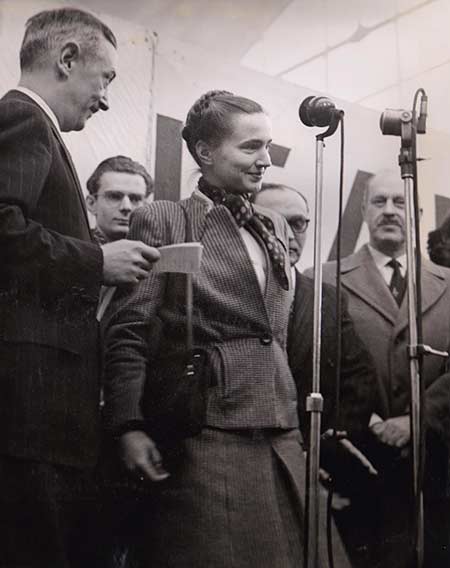 |
In this picture, I make my bow to the welcoming crowds. Blake stands to the left to introduce me, Drew Pearson is on the right. |
Each
day aboard the Train began with breakfast in the dining-car, during
which Blake and I reviewed the short speeches he would make in that
day's towns. When the train stopped in mid-morning at the first
city, we all emerged from inside the train onto the flatbed car.
There, Pearson, Blake, welcoming French officials, responding Americans
and others addressed the crowd, after which the rest of us in the
train's contingent were individually introduced, stepping forward
to take our individual bows-to cheers, applause and much flag-waving
from the assembled French people on the station platform below.
These
public outdoor ceremonies were then followed by another official
welcome elsewhere, either inside the train station or at some more
formal vin d'honneur or town hall reception, all liberally
punctuated with additional speeches and champagne toasts. While
we were being fêted, that town's token boxcar was detached from
the train, its contents to be distributed later. (To the best of
my understanding, the goods unloaded from the Train at this time
were token distributions only, heralds of more extensive deliveries
to follow.) When the ceremonies were over, the Train resumed its
progress, to repeat the program that afternoon in the next city.
On
December 22nd, we arrived at Dijon in the morning and at Lyon in
the afternoon. On the 23rd, Valence was our first stop, Avignon
the second. Overnight stops were at Lyon and Avignon after evening
ceremonies in each city.
The
grandest event to which we were treated was at Lyon, where the mayor
and members of the municipal council entertained us and a vast company
of guests at a lavish banquet, served at what seemed like a mile-long
table, in a beautiful, historic hall-the French no doubt having
pooled all their ration books, coupons and special allotments to
honor us. The food was spectacular, the wine flowed freely, and
the whole ambiance was elegant and dazzling, almost like a royal
affair. Evening ran into night, speeches were made, glasses raised
to Franco-American amity, after which we all made our way back to
the train, replete, replenished-and rather weary.
By
the time we reached Marseille, it was mid-morning of December 24th,
Christmas Eve, and I was exhausted from the excitement, the long
hours, the early risings, the consumption of rich food and alcohol-to
which at the age of twenty-one, I was definitely not accustomed!
After
that morning's vin d'honneur at the town hall, we remained
in Marseille for some while, probably going on to luncheon somewhere
afterwards. In late-afternoon some of us departed via what chanced
to be my first-ever airplane flight, chartered especially for our
party courtesy of Air France. That night, we were back in Paris.
For
the next month thereafter, Blake and I attended several food distributions
at schools and orphanages in the metropolitan area, kept up with
the paperwork, and prepared to oversee the bulk of the distributions
throughout France when and as the rest of the merchandise would
arrive from the U.S.
*
* * * * * * * * *
Then
all too soon came the shock that left us all aghast.
On
Friday, January 30, 1948, we learned that the Entr'Aide Française
warehouse, where the Friendship Train merchandise was stored, had
been the object of arson during the early hours of the morning. Everything in it had gone up in flames. The French press
reported that fires had been simultaneously lit in three different
places, and that the Paris police had determined they were criminally
set. No one doubted that this was the work of Communist saboteurs,
then extremely active in France and bent upon undermining American
influences in every possible way.
Few
Americans realize today, as relatively few did then, how serious
a threat Communism posed in Europe after the war, especially in
France and Italy. In fact, one reason why Pearson had designated
those two countries as Friendship Train beneficiaries was precisely
to counter its influence there. Communism had gained credibility
in Europe during the war partly because it opposed Fascism, and
partly because a considerable number of Communists had been Resistance
fighters in their respective countries. When the war ended they
emerged in force to promote their take-over Communist agenda-in
line with Soviet policies later developed full-scale during the
Cold War. Inevitably, the Party line fiercely opposed any American
goodwill initiatives, and notably any widespread publicity relating
thereto.
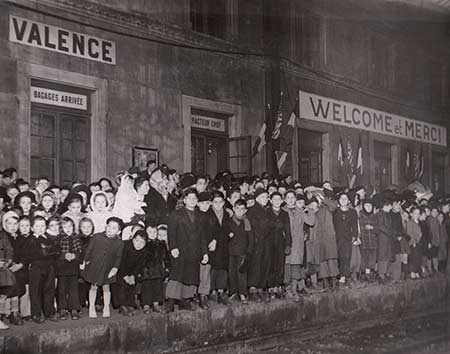 |
This photo taken in the station at Valence gives a sample view of the crowds that greeted us at every stop. |
Tragically,
nothing was saved from the monster fire. Everything in the warehouse
was annihilated. Except for the token distributions we had already
made from the Train on its tour, plus a few others made locally
on our return, some thousands of French children and senior citizens
would be deprived of the food that American sympathizers had sent
them. Was this ever reported in the American press? I have no idea.
In
my Friendship Train album, a 29 December 1947 clipping from Le
Figaro briefly describes a small ceremony that had taken place
the day before the fire at the warehouse, where "1500 tons" of merchandise
destined for the département of the Seine were stored. There,
apparently, the prefect of the Seine and other notables had been
welcomed by the president of Entr'Aide, and there Blake himself
had opened the warehouse gates in a symbolic gesture to admit the
Entr'Aide trucks which would soon be transporting that merchandise.
Looking at that short article today, I cannot help but wonder if
it, or another like it in some other newspaper, is what tipped off
the saboteurs who would set fire to that selfsame warehouse the
following day.
The
same article also states that, between 20 December 1947 and 20 January
1948, thirty-one towns had already received close to "2000 tons"
of Friendship Train merchandise, and that, in the département of Seine, 232,000 people had already been beneficiaries. What its
author could not know at the time of writing was how many others
would never benefit from the supplies annihilated by the fire.
Another
Paris newspaper, dated 30 January 1948, says that "more than half
of the Friendship Train merchandise, specifically 2000 tons destined
for the département of Seine," had been reduced to ashes, adding
that up to that point "only 85 tons had been distributed." (Obviously
I cannot vouch for the accuracy of any of the newspaper articles,
of which in any case I retain only a few. They reported what they
assumed at the time to be accurate, but I have no way of verifying
their figures. Nor can I speak to the precise difference between
French "tonnes" and American "tons," although I do know they are
different.)
*
* * * * * * * * *
At
our AAtF Paris office, even as distributions in other parts of France
continued, some of us spent the next several months working at the
heartbreaking task of evaluating losses, AAtF's own as well as the
Friendship Train's, as our organization also had merchandise stored
in that warehouse. Soon after the fire, I moved downstairs to the
office of Louis Clamaron, our shipping director, to help him deal
with the job so unexpectedly thrust upon us. Thereafter I was no
longer closely in touch with what happened upstairs with regard
to later Friendship Train distributions.
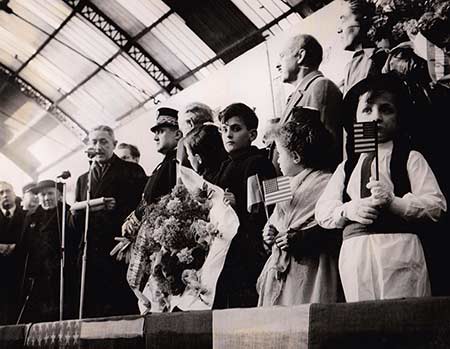 |
At several stops, French children were among those who climbed aboard the flat-bed car with us to express their thanks for Friendship Train merchandise. |
Poor
Clamaron: not only did he still have his regular job of overseeing
AAtF shipments from New York to Paris and our seven centers, he
now had all the additional minutiae of Friendship Train losses to
deal with, including the compilation of lists of those losses and
estimates of their value. Among my Friendship Train memorabilia,
I have carbon copies of those lists, signed at the bottom with Clamaron's
name and my own. One such list, thirty-eight pages long, dated 7
June 1948, puts AAtF's losses at 102,950,864 French francs' worth.
Another list under the same date cites 404,445,450 French francs
as the value of Friendship Train merchandise lost in the fire. What
those totals equated to in American dollars, I do not know as I
have not attempted to ascertain their equivalencies in dollars then
or now.
Fortunately,
the losses Clamaron and I recorded did not represent the entirety
of merchandise collected for France in the United States, as later
Friendship Train shipments arrived and were successfully delivered.
I have no idea what proportion of the total was incinerated, nor
how much survived elsewhere, to be distributed afterwards. Ours
was a dreary, nose-to-the-grindstone, tunnel-vision sort of task,
which was concluded only a short while before I ended my time with
American Aid to France.
*
* * * * * * * * *
Meanwhile
in the United States during the preceding year, the U.S. government's
program of economic aid to Europe had been taking shape, which in
time would help rebuild and unify Europe, contain Communism, and
establish America as an international super-power. This four-year
program, known officially as the European Recovery Program and more
familiarly as 'the Marshall Plan,' would be implemented by an autonomous,
un-bureaucratic agency, operating independently of the State Department,
called the Economic Cooperation Administration (E.C.A.). Administered
in Washington by Paul G. Hoffman and in Europe by Averell Harriman,
E.C.A. would help seventeen western European nations recover from
the war, disbursing in the process some $13 billion dollars (about
$100 billion in today's terms) in economic aid and technical assistance.
As a corollary, it would also replace the work of private post-war
relief organizations like American Aid to France.
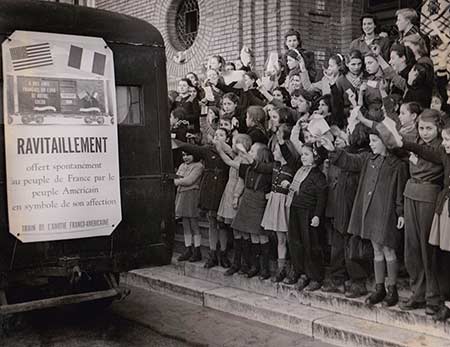 |
After our return to Paris, Blake and I attended several distributions to orphanages outside the city. Here, children at one of them line up to greet the arrival of a Friendship Train truck loaded with food for their consumption. |
This
being so, Blake called me into his office one afternoon and told
me that, prior to terminating its activities altogether, our organization
would soon begin downsizing its Paris and regional operations, beginning
with American personnel who were paid in dollars. He suggested that,
in anticipation of AAtF lay-offs, I might like to take a position
with the Marshall Plan, which just then was setting up its European
headquarters in Paris. If I saw fit to choose this option, he would
recommend me to Ambrose Chambers (a former AAtF board member), who
was already in town as special assistant to E.C.A. ambassador-at-large
Averell Harriman.
Thus
it was that, on 18 June 1948, I became a member of Harriman's advance
team. At that time we were still just a small crew, and E.C.A. headquarters
was temporarily housed in the American Embassy Annex, next door
to the embassy itself, on the Avenue Gabriel just off the Place
de la Concorde. Later that summer or by early fall of 1948, we would
move out of the Annex and across the place to the beautiful
historic Hôtel de Talleyrand at 2 rue St. Florentin, then newly
acquired by the American government. In this new job with the Marshall
Plan, I started as secretary to Brose Chambers, and in due course
would also find myself working directly for Harriman.
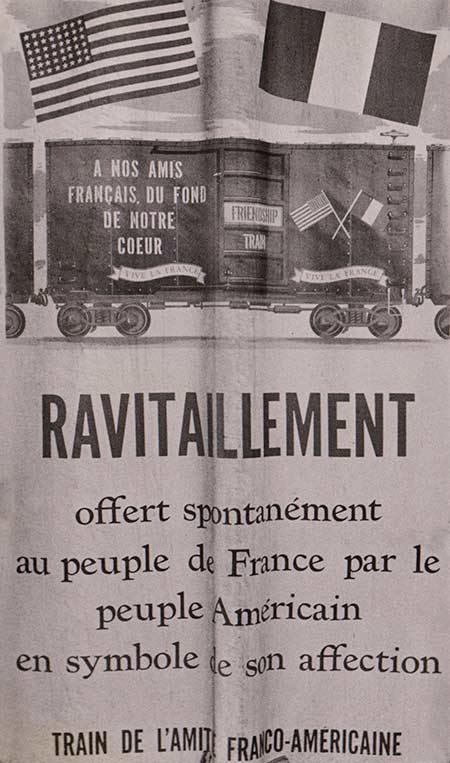 |
I have seen photos of this poster used erroneously in connection with the Marshall Plan. However, as illustrated here (and as shown in my seventh photo above), it has no connection whatever with that government initiative, which followed the Friendship Train by at least six months. As the bottom line of the poster's text makes clear, it was used exclusively in connection with Friendship Train food distributions in France. |
How
much longer after my departure American Aid to France continued
to operate in either France or the U.S., I do not now recall. At
some point, Blake himself left AAtF to join the Guaranty Trust Company,
also located on the Place de la Concorde. In due course, he and
several other AAtF members, plus other Americans associated with
the Friendship Train, would receive the Médaille de la Reconnaissance
Française from a grateful French government, bestowed on them
at the Elysée palace by French president Vincent Auriol.
As
for me, I would continue working in Paris for the Marshall Plan. When its work was done in the early 1950s, its offices were replaced
by those of the American Mission to the North Atlantic Treaty Organization
in the same rue St. Florentin building, where I would become secretary
to two successive American ambassadors to N.A.T.O, first The Honorable
John Chambers Hughes and then The Honorable George Walbridge Perkins.
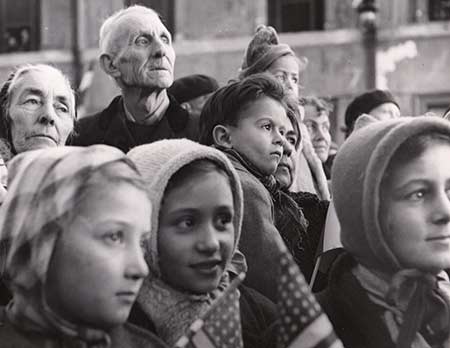 |
As children and the elderly were the designated beneficiaries of Friendship Train merchandise, this photo eloquently captures the interest and expectation of some who turned out to greet the Train as it crossed France. |
Finally,
in late-fall of 1955, after nearly nine years abroad, I returned
to the U.S. to marry an American attorney I had met in Paris.
By
then, far from having spent abroad the single year I'd originally
planned, I had been away from home for virtually the entire decade
of my twenties, from age twenty-one to twenty-nine, during what
was not only the time of my youth but also a period unique in history.
When those of us who had worked for programs such as these returned
to America, it was with the sure and certain knowledge that, in
however small a capacity, we had done useful, productive work by
contributing our time and effort to the cause of peace after a long
and brutal war.
*
* * * * * * * * * *
Meanwhile,
the story of the Friendship Train should not end with me. I was
there, I was part of it, and I still retain photographs, newspaper
clippings and other mementoes of that momentous time. When I arrived
in Paris during the summer of 1947, I was twenty-one years old.
When I left AAtF, I was twenty-two. By the time I left Paris to
be married in the U.S., I was twenty-nine. At the time of this writing,
I am eighty-five, with my mental faculties intact and my memories
still vivid. But somehow, somewhere, other than in me, the knowledge
should be preserved of a magnificent gesture that sprang spontaneously
from the heart of one nation for the benefit of another. Along with
the Marshall Plan, the G.I. Bill of Rights, the Berlin Air Lift,
and perhaps a few other model programs initiated by the United States
in those bygone days, the Friendship Train was evidence of a spirit
and a people whose generosity was recognized around the world. While,
sadly, that no longer seems so evident today, tribute should nonetheless
be paid to those thousands of ordinary citizens who gave expression
to it then.
Kennett
Square, Pa. - 2011
Return
to Friendship Train Home |
|

